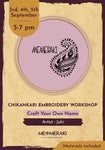About Chikankari
Chikankari is a traditional embroidery style that originated in Lucknow, India. Known for its intricate and delicate designs, Chikankari has a rich history that dates back several centuries. This craft has been passed down through generations, creating beautiful embroidery that are both elegant and timeless.
History and Tradition
Chikankari has a storied history in India, with roots believed to stretch back to the Mughal era. According to legend, the craft was introduced to India by Nur Jahan, the wife of Mughal Emperor Jahangir, in the 17th century. She was known for her exquisite taste in fashion and is said to have encouraged the development of Chikankari as a popular form of embroidery. However, there are different versions of stories revolving around Chikankari. A popular tale speaks about a traveler who taught this craft to a peasant in Lucknow in return for his hospitality to a stranger.
Techniques and Styles
The hallmark of Chikankari is its intricate and delicate embroidery. Artisans use a variety of stitches to create elaborate patterns on fine fabric, typically muslin or cotton. The traditional Chikankari technique involves hand embroidery using a needle and thread to create a range of stitches like Bakhiya (Shadow Work, creating patterns on the reversed side of the fabric), Phanda (Knots), Jali (Net Effect), etc. Chikankari often features floral motifs and patterns like paisleys, vines, and geometric designs. The embroidery is typically white, but contemporary Chikankari has embraced a broader color palette and material.










